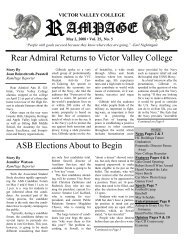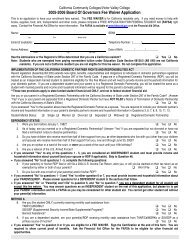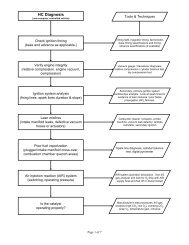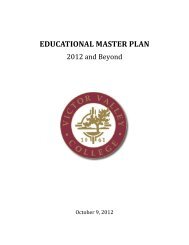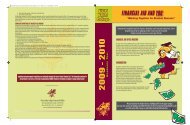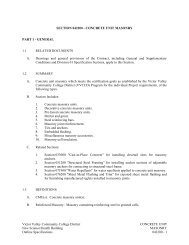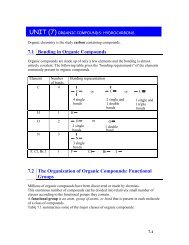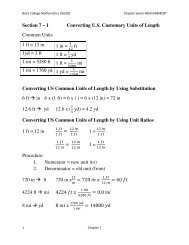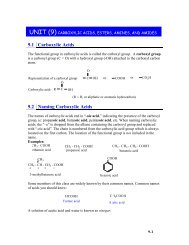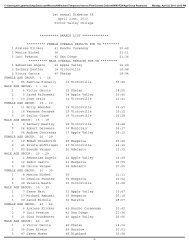Download - Victor Valley College
Download - Victor Valley College
Download - Victor Valley College
You also want an ePaper? Increase the reach of your titles
YUMPU automatically turns print PDFs into web optimized ePapers that Google loves.
PROGRAMS / COURSE DESCRIPTION<br />
requirements. CIDG 138 may be used as Elective credit<br />
but may not be used to fulfill major requirements.<br />
Transfer<br />
Not a transfer major. Most CIDG courses transfer as<br />
Electives or fulfill subject credit requirements. Some<br />
CIDG courses fulfill lower division requirements for a<br />
related major. Students in this program sometimes<br />
choose to pursue a bachelor’s degree in Architecture or<br />
Engineering. See Architecture and Engineering for<br />
transfer requirements for these majors.<br />
COMPUTER INTEGRATED<br />
DESIGN AND GRAPHICS COURSES<br />
CIDG 50 DRAFTING LABORATORY<br />
Units: 1.0-4.0 - 48-54 hours of laboratory required for<br />
each unit. (No prerequisite. Grade Option) This course<br />
may be taken two times.<br />
Drafting laboratory provides the additional time,<br />
equipment, and instruction necessary to develop<br />
problem solving, board or AutoCAD skills at each<br />
individual’s own pace.<br />
CIDG 65 3DS MAX ADVANCED EFFECTS AND<br />
COMPOSITING<br />
Units: 3.0 - 32-36 hours lecture and 48-54 hours<br />
laboratory. (Prerequisite: CIDG 260. Grade Option) This<br />
course may be taken four times.<br />
Students will learn advanced concepts and procedures<br />
required for creating high quality 3D special effects.<br />
Topics will include particle systems, Space Warps, and<br />
MassFX. Rendering techniques incorporating depth of<br />
field, motion blur, and anti-aliasing filters will also be<br />
discussed. Alpha channel compositing techniques will<br />
be addressed in detail. Students will also explore and<br />
analyze relevant issues pertaining to the computer<br />
animation industry.<br />
CIDG 70 DESIGN FOR GRAPHIC ARTISTS<br />
Units: 3.0 - 48-54 hours lecture. (No prerequisite)<br />
This course covers the fundamental elements and<br />
principles of design. This course uses demonstration of<br />
the fundamentals and reinforces them through<br />
assignments and projects. Emphasis will be placed on<br />
developing techniques and vocabulary that will enable<br />
the student to problem solve and communicate ideas,<br />
concepts and solutions. Students will also learn how to<br />
properly critique design.<br />
CIDG 72 COMPUTER ILLUSTRATION<br />
Units: 3.0 - 32-36 hours lecture and 48-54 hours<br />
laboratory. (No prerequisite)<br />
This course covers the fundamental elements of<br />
illustration including history, design, color theory and<br />
appropriateness for specified use in the graphics<br />
industry. Students will create a series of illustrations<br />
using software techniques and skills developed through<br />
lectures, demonstration and assigned projects.<br />
CIDG 73 TYPOGRAPHY AND LAYOUT<br />
Units: 3.0 - 32-36 hours lecture and 48-54 hours<br />
laboratory. (No prerequisite)<br />
In this course students will learn how to use type as a<br />
graphic design element using industry standard<br />
techniques and tools. Students will strengthen their use<br />
of type as a design element through a variety of projects<br />
ranging from elementary exercise to intermediate<br />
presentations. In addition, students will examine the<br />
history of type and typesetting, modern methodologies,<br />
principles and aesthetics of good typographic design.<br />
CIDG 75 PAGE LAYOUT AND DESIGN<br />
Units: 3.0 - 32-36 hours lecture and 48-54 hours<br />
laboratory. (No prerequisite)<br />
This course introduces students to the computer as a<br />
page layout and design tool. Emphasis will be on using<br />
industry standard software to simplify the paste-up and<br />
pagination process when producing multi-page printed<br />
materials. Students will learn the terminology and<br />
techniques of page layout so that they may<br />
communicate within the industry. Class projects will<br />
develop the ability to work as a team to produce printed<br />
materials within time and technical constraints.<br />
CIDG 77 PRINT PRODUCTION PROCESSES<br />
Units: 3.0 - 32-36 hours lecture and 48-54 hours<br />
laboratory. (No prerequisite)<br />
A study of the processes used in the printing industry.<br />
Emphasis will be placed on terminology, practices, and<br />
techniques for effective communication with printing<br />
professionals. Class projects will develop the students’<br />
ability to design within the necessary parameters.<br />
CIDG 79 MULTIMEDIA AND WEB DESIGN<br />
Units: 4.0 - 48-54 hours lecture and 48-54 hours<br />
laboratory. (No prerequisite. Grade Option)<br />
This course teaches graphic artist the tools and<br />
procedures for designing graphics for the computer<br />
screen. This course will give an overview of standard<br />
industry software used for creating multimedia<br />
presentation and web pages. This course does not<br />
focus on HTML or scripting language but is focused on<br />
the development of the visual content.<br />
COMPUTER INTEGRATED DESIGN AND GRAPHICS<br />
2012-2013 <strong>Victor</strong> <strong>Valley</strong> <strong>College</strong> Catalog 179



